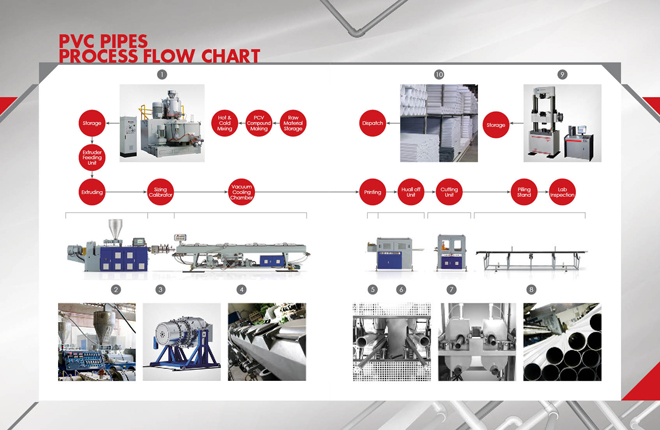THE DIFFERENCE IS QUALITY!
- Plastic Pipes
- UPVC Pipes
- CPVC Pipes
- Electric Conduit Pipes
- PPRC Pipes
- PE Pipes
- PVC Piping System
- Chemical Resistance Chart
-
Process Flow Chart
Steelex PVC piping system offer a comprehensive range of pipes and fitting to cater to growing need of the water, sewerage, building construction industry.
STANDARDS
All PVC pipes and fittings are manufactured as per the following standards:
- UPVC Schedule 40 pipes are manufactured in strict compliance with ASTM D-1785
- CPVC Schedule 40 pipes are manufactured in strict compliance with ASTM F-441
- Pressure rated (SDR Series) pipes are manufactured in strict compliance with ASTM D-2241
- All PVC pipes are produced from compound which confirms ASTM D-1784
- All fittings for above pipes according to ASTM D-2466 & D-2665
RANGE
Steelex UPVC & CPVC Pipes & Fittings are available in following sizes:
- UPVC Pipes (Schedule 40) : ½" to 12"
- UPVC Pipes (SDR Series) : 2" ~ 8"
- CPVC Pipes (Schedule 40) : ½" ~ 1"
- PVC Electric Conduit Pipes : ½" ~ 4"
ADVANTAGES OF STEELEX PVC PIPING SYSTEM
| Easy to Install | Tough, Impact-resistance and easy to install. |
| Corrosion Resistance | UPVC is non-corrosive and hence constant with water does not deteriorate the material. |
| Chemical Resistance | Excellent chemical resistance of UPVC to acids, alkalis and oxidizing. |
| Non-inflammable | UPVC does not support combustion and is self-extinguishing. |
| Non-Conductive | UPVC is a non-conductor and hence not attacked by galvanic or electrolytic action. |
| Weather Resistance | Specially blended UV stabilized compound offers an excellent outdoor weathering performance. High durability. |
| High Flow Rate | The smooth internal bore gives excellent flow properties which remain constant throughout the life of the system. |
CHEMICAL |
73o F |
140o F |
CHEMICAL |
73o F |
140o F |
Acetic Acid, 20% |
R |
R |
Diesel fuels |
N |
N |
Acetic Acid, 80% |
R |
C |
|||
Acetic Acid |
R |
R |
Disodium Phosphate |
R |
R |
Diglycolic Acid |
R |
R |
|||
Ammonia, Gas |
R |
R |
|||
Ammonia, Liquid |
N |
N |
Detergent, aq |
R |
R |
Dichlorobenzene |
N |
N |
|||
Ammonium Salts |
R |
R |
N |
N |
|
Ammonium Fluoride, 25% |
R |
C |
Ethers |
N |
N |
Benzene (Benzal) |
N |
N |
Fatty Acids |
R |
R |
Benzene Sulfonic Acid, 10% |
R |
R |
Ferric Salts |
R |
R |
Benzene Sulfonic Acid |
N |
N |
Fluorine, Dry Gas |
C |
N |
Benzonic Acid |
R |
R |
Fluorine, Wet Gas |
C |
N |
Fluoboric Acid, 25% |
C |
R |
|||
Bleach, 12.5% Ative Chlorine |
R |
R |
|||
Bleach, 5.5% Ative Chlorine |
R |
R |
Formic Acid |
R |
N |
Boric Acid |
R |
R |
Fruit Juice and Pulps |
R |
R |
Fuel Oil |
C |
N |
|||
Bromic Acid |
R |
R |
Furfural |
N |
N |
Gas, Coal, Manufactured |
N |
N |
|||
Calcium Salts, aq |
R |
R |
Gas, Natural, Methane |
R |
R |
Calcium Hypochlorite |
R |
R |
|||
Calcium Hydroxide |
R |
R |
Gasolines |
C |
C |
Carbon Dioxide |
R |
R |
Gelatin |
R |
R |
Carbon Dioxide, aq |
R |
R |
Glycerin (Glycerol) |
R |
R |
Carbon Momoxide |
R |
R |
Glycols |
R |
R |
Castor Oil |
R |
R |
Glycolic Acid |
R |
R |
Causticpotash (Potassium Hydroxide) |
R |
R |
Gallic Acid |
R |
R |
Caustic Soda (Sodium Hydroxide) |
R |
R |
|||
Hydrobromic Acid, 20% |
R |
R |
|||
Chloric Acid, 20% |
R |
R |
Hydrochloric Acid |
R |
R |
Hydrogen |
R |
R |
|||
Chlorine, Gas, Dry |
C |
N |
Hydrogenperoxide, 50% |
R |
R |
Chlorine, Gas, Wet |
N |
N |
Hydrogenperoxide, 90% |
R |
R |
Chlorine, Liquid |
N |
N |
|||
Chlorine, Water |
R |
R |
Iodine, Alc |
N |
N |
Chlorine, Acid |
R |
R |
Jet Fuels, JP-4 and JP-5 |
R |
R |
Chlorosulfonic Acid |
R |
N |
Kerosene |
R |
R |
Chloromic Acid, 10% |
R |
R |
Ketones |
N |
N |
Lastic Acid, 25% |
R |
R |
|||
Citric Acid, 50% |
R |
R |
|||
Coconut Oil |
R |
R |
Lead Salt |
R |
R |
Coke Oven Gas |
R |
R |
Linoleic Acid |
R |
R |
Linseed Oil |
R |
R |
|||
Copper Salt, aq |
R |
R |
|||
Corn Oil |
R |
R |
Lithium Salts |
R |
R |
Corn Syrup |
R |
R |
Lubricating Oils |
R |
R |
Cresylic Acid, 50% |
R |
R |
Machine Oil |
R |
R |
Crude Oil |
R |
R |
Magnesium Acid |
R |
R |
Mercuric Salts |
R |
R |
Stannic Chloride |
R |
R |
Mercury |
R |
R |
Stannous Chloride |
R |
R |
Metallic Soaps, aq |
R |
R |
Starch |
R |
R |
Methane |
R |
R |
Stearic Acid |
R |
R |
Stoddard Solvent |
N |
N |
|||
Milk |
R |
R |
|||
Mineral Oil |
R |
R |
Sulfur |
R |
R |
Mixed Acids (Sulfuric & Nitric) |
C |
N |
Sugars, aq |
R |
R |
Mixed Acids (Sulfuric & Phosphoric) |
R |
R |
Sulfur Dioxide, Dry |
R |
R |
Sulfur Dioxide, Wet |
R |
C |
|||
Motor Oil |
R |
R |
|||
Sulfur Trioxide, Gas, Dry |
R |
R |
|||
Nickle Salt |
R |
R |
Sulfur Trioxide, Wet |
R |
C |
Sulfuric Acid, up to 70% |
|||||
Nitric Acid, 0 to 50% |
R |
C |
Sulfuric Acid, 70 to 90% |
R |
C |
Sulfuric Acid, 70 to 100% |
C |
N |
|||
Oil, Vegetable |
R |
R |
Sulfurous Acid |
C |
N |
Oils and Fats |
R |
R |
|||
Oleic Acid |
R |
R |
Tartic Acid |
R |
R |
Taetrachloroethance |
C |
C |
|||
Olive Oil |
C |
- |
Tetraethly Lead |
R |
C |
Oxygen, Gas |
R |
R |
Terahydrofuran |
N |
N |
Thionyl Chloride |
N |
N |
|||
Paraffin |
R |
R |
|||
Petroleum, Sour |
R |
R |
Thread Currint Oils |
R |
- |
Petroleum, Refined |
R |
R |
Terpineol |
C |
C |
Titanium Tetrachloride |
C |
N |
|||
Phosphoric Acid |
R |
R |
Tolueu |
N |
N |
Phosphorus, Yellow |
C |
R |
Tributyl Phosphate |
N |
N |
Phosphorus, Red |
R |
R |
|||
Tributyl Citrate |
R |
- |
|||
Photographic Chemicals, aq |
R |
R |
Tricresyl Phosphate |
N |
N |
Picric Acid |
N |
N |
Trichloroacetic Acid |
R |
R |
Potassium Salts, aq |
R |
R |
Trichlorothylene |
N |
N |
Sea Water |
R |
R |
Urea |
R |
R |
Salicylic Acid |
R |
R |
Urine |
R |
R |
Salicyladehyde |
C |
C |
|||
Selenic Acid |
R |
R |
Vaseline |
N |
N |
Sewage, Residential |
R |
R |
Vegetable Oil |
R |
R |
Slicic Acid |
R |
R |
Vinegar |
R |
R |
Silicone Oil |
R |
R |
|||
Silver Salts |
R |
N |
Water, Distilled |
R |
R |
Soaps |
R |
R |
Water, Fresh |
R |
R |
Sodium Salts, aq, Except |
R |
R |
Water, Mine |
R |
R |
Sodium Chlorite |
R |
R |
Water, Salt |
R |
R |
Sodium Chlorite |
R |
C |
Water, Tap |
R |
R |
Sodium Dichromate, Acid |
R |
R |
|||
Sodium Perborate |
R |
R |
Zinc Salt |
R |
R |
| R = Generally resistant C = Less resistant than R but still suitable for some conditions N = Not resistant This table is meant to aid designer in decisions as to transporting / conveyance of undiluted chemicals. |
|||||

